
Stanley FatMax PP1DCS 100 Amp Power Station
About Stanley Tools
Stanley Tools is a brand of hand tools, power tools, and accessories manufactured by Stanley Black & Decker. The company has been in business since 1843 and is known for producing high-quality tools that are both durable and reliable. Stanley Tools offers a wide range of products, including hammers, screwdrivers, saws, levels, tape measures, and more.
The brand is known for its innovation and has introduced several patented technologies, such as Anti-Vibe handles, FatMax blades, and Smart Measure Pro. Whether you’re a professional contractor or a DIY enthusiast, Stanley Tools offer a variety of options to meet your needs.
FEATURES CARACTERÍSTICAS
FEATURES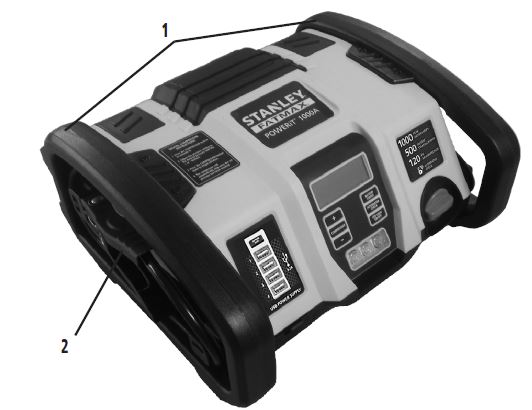
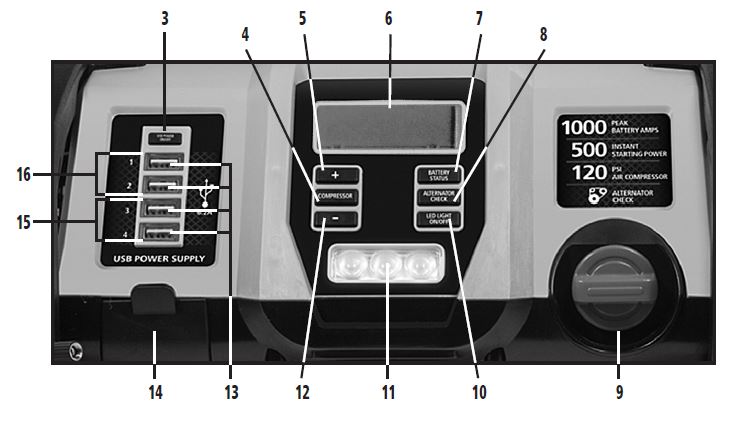

- Handle/roll bar
- Negative (–) black clamp
- USB power button
- Compressor Power Button
- Compressor Pressure Control Button (+)
- Backlit LCD screen
- Battery Status Button
- Alternator Check Button
- Jump Starter Power Switch
- Area Light Power Button
- LED Area Light
- Compressor Pressure Control Button (–)
- USB ports
- Built-in 120 volt AC charger (under protective cover)
- Lower USB Power/Fault Indicators
- Upper USB Power/Fault Indicators
- Storage Compartment cover
- Storage Compartment
- Nozzle adapter
- Air hose and SureFit™ nozzle
- Positive (+) red clamp
CARACTERÍSTICAS
- Mango / barra antivuelco
- Pinza negra del negativo (–)
- Botón de alimentación USB
- Botón de alimentación del compresor
- Botón de control de presión del compresor (+)
- Pantalla del LCD retroiluminada
- Botón de estado de la batería
- Botón de verificación del alternador
- Interruptor del puente auxiliar de arranque
- Botón de encendido de la luz de área
- Luz de área LED
- Botón de control de presión del compresor (–)
- Puertos USB
- Cargador de CA de 120 voltios incorporado (bajo cubierta protectora)
- Indicadores inferior de USB potencia / fallo
- Indicadores superior de USB potencia / fallo
- Cubierta del compartimiento del almacenaje
- Compartimiento del almacenaje
- Adaptador de boquilla
- Manguera e boquilla de SureFit™
- Pinza roja del positivo (+)
DIGITAL LCD SCREEN / PANTALLA DEL LCD DIGITAL
SAFETY GUIDELINES / DEFINITIONS
DANGER: Indicates an imminently hazardous situation that, if not avoided, will result in death or serious injury.
WARNING: Indicates a potentially hazardous situation that, if not avoided, could result in death or serious injury.
CAUTION: Indicates a potentially hazardous situation which, if not avoided, may result in minor or moderate injury.
CAUTION: Using without the safety alert symbol indicates a potentially hazardous situations which, if not avoided, may result in property damage.
RISK OF UNSAFE OPERATION. When using tools or equipment, basic safety precautions should always be followed to reduce the risk of personal injury. Improper operation, maintenance, or modification of tools or equipment could result in serious injury and property damage. There are certain applications for which tools and equipment are designed. The manufacturer strongly recommends that this product NOT be modified and/or used for any application other than for which it was designed. Read and understand all warnings and operating instructions before using any tool or equipment
IMPORTANT SAFETY INSTRUCTIONS
WARNING: Read all instructions before operating the power station. Failure to follow all instructions listed below may result in electric shock, fire, and/or serious injury
GENERAL SAFETY WARNINGS AND INSTRUCTIONS
WARNING: This product or its power cord contains lead, a chemical known to the State of California to cause cancer and
birth defect or other reproductive harm. Wash hands after handling.
• This unit was designed for household use only.
WARNING: RISK OF FIRE, ELECTRIC SHOCK, BURST HAZARD, OR INJURY TO PERSONS OR PROPERTY
- Avoid dangerous environments. Don’t use appliances in damp or wet locations. Don’t use appliances in the rain.
- Keep children away. All visitors should be kept at a distance from the work area.
- Dress properly. Do not wear loose clothing or jewelry. They can be caught in moving parts. Rubber gloves and substantial, non-skid footwear are recommended when working outdoors. Wear protective hair covering to contain long hair.
- Store idle appliances indoors. When not in use, appliances should be stored indoors in dry, and high or locked-up places – out of reach of children.
- Don’t abuse the cord. Never carry the appliance by a cord or yank it to disconnect it from the receptacle. Keep cord from heat, oil, and sharp edges.
- Disconnect appliances. Disconnect the appliance from the power supply when not in use, before servicing, and when changing accessories.
- Ground Fault Circuit Interrupter (GFCI) protection should be provided on the circuits or outlets to be used. Receptacles are available having built-in GFCI protection and may be used for this measure of safety.
- Use of accessories and attachments. The use of any accessory or attachment not recommended for use with this appliance could be hazardous. Refer to the accessory section of this manual for further details.
- Stay alert. Use common sense. Do not operate this equipment when you are tired or impaired.
- Check for damaged parts. Any part that is damaged should be replaced by the manufacturer before further use. Do not use tool if the switch does not turn it on and off. Contact the manufacturer at (877) 571-2391 for more information.
- Do not operate this appliance near flammable liquids or in gaseous or explosive atmospheres. Motors in these tools normally spark, and the sparks might ignite fumes.
- Never submerge this unit in water; do not expose it to rain, or snow or use it when wet.
- To reduce the risk of electric shock, disconnect the unit from any power source before attempting maintenance or cleaning. Turning off controls without disconnecting will not reduce this risk.
- This equipment employs parts (switches, relays, etc.) that produce arcs or sparks. Therefore, if used in a garage or enclosed area, the unit MUST be placed not less than 18 inches above the floor
EXTENSION CORDS:
WARNING: Use of improper extension cord could result in a risk of fire and electric shock. When using an extension cord, make sure that the pins of the extension cord are the same number, size, and shape as those in the charger; and be sure to use one heavy enough to carry the current your product will draw. An undersized cord will cause a drop in line voltage resulting in loss of power and overheating. The following table shows the correct size to use depending on cord length and nameplate ampere rating. If in doubt, use the next heavier gauge. The smaller the gauge number, the heavier the cord.
When an extension cord is used, make sure that:
- the pins of the extension cord are the same number, size, and shape as those in the charger,
- the extension cord is properly wired and in good electrical condition,
- the wire size is large enough for the AC rating of the charger.
CAUTION: TO REDUCE THE RISK OF INJURY OR PROPERTY DAMAGE: Pull the extension cord by the plug rather than the cord when disconnecting from the built-in 120-volt AC charger or the AC outlet.
SPECIFIC SAFETY INSTRUCTIONS FOR JUMP STARTERS
WARNING: BURST HAZARD
Do not use the unit for charging dry-cell batteries that are commonly used with home appliances. These batteries may burst and cause injury to persons and damage property. Use the unit for charging/boosting a lead-acid battery only. It is not intended to supply power to a low-voltage electrical system other than in a starter-motor application.
- Use of an attachment not supplied, recommended, or sold by the manufacturer specifically for use with this unit may result in a risk of electrical shock and injury to persons.
WARNING: RISK OF EXPLOSIVE GASES
- Working in the vicinity of a lead-acid battery is dangerous. Batteries generate explosive gases during normal battery operation. For this reason, it is of the utmost importance that each time before using the jump-starter you read this manual and follow the instructions exactly.
- To reduce the risk of battery explosion, follow these instructions and those published by the battery manufacturer and manufacturer of any equipment you intend to use in the vicinity of the battery. Review cautionary markings on these products and on the engine.
CAUTION: TO REDUCE THE RISK OF INJURY OR PROPERTY DAMAGE:
- NEVER ATTEMPT TO JUMP-START OR CHARGE A FROZEN BATTERY.
- Vehicles that have onboard computerized systems may be damaged if the vehicle battery is jump-started. Before jump-starting, read the vehicle’s owner’s manual to confirm that external-starting assistance is suitable.
- When working with lead acid batteries, always make sure immediate assistance is available in case of an accident or emergency.
- Always have protective eyewear when using this product: contact with battery acid may cause blindness and/or severe burns. Be aware of first aid procedures in case of accidental contact with battery acid.
- Have plenty of fresh water and soap nearby in case battery acid contacts the skin.
- Never smoke or allow a spark or flame in the vicinity of the vehicle battery, engine, or power station
- Stay clear of fan blades, belts, pulleys, and other parts that can cause injury to persons.
- Remove personal metal items such as rings, bracelets, necklaces, and watches when working with a lead acid battery. A
lead acid battery can produce a short circuit current high enough to weld a ring, or similar metal object, to the skin, causing a severe burn. - Do not wear vinyl clothing when jump-starting a vehicle. Friction can cause dangerous static-electrical sparks.
- Be extra careful to avoid dropping a metal tool onto the battery. It might spark or short-circuit the battery or another electrical part and could cause an explosion.
- Jump-start procedures should only be performed in a safe, dry, well-ventilated area.
- Always store battery clamps when not in use. Never touch battery clamps together. This can cause dangerous sparks, power arcing, and/or explosion.
SPECIFIC SAFETY INSTRUCTIONS FOR CHARGING THIS UNIT
- IMPORTANT: This unit is delivered in a partially charged state. Fully charge the unit with a household extension cord for a full 40 hours or until the battery status icon shows 4 solid bars before using it for the first time. You cannot overcharge the unit using the AC charging method.
- To recharge this unit, use only the built-in AC charger with an AC extension cord (not included)
- All functions should be turned off when the unit is charging or not in use. Make sure all functions are turned off before connecting to a power source or load.
- When using this unit close to the vehicle’s battery and engine, stand the unit on a flat, stable surface, and be sure to keep all clamps, cords, clothing, and body parts away from moving vehicle parts.
- Never allow red and black clamps to touch each other or another common metal conductor — this could cause damage to the unit and/or create a sparking/explosion hazard.
- Make sure to connect the clamps with the correct polarity. Damage caused by improper connection is not covered by the Warranty.
- Do not expose the battery to fire or intense heat since it may explode. Before disposing of the battery, protect exposed terminals with heavy-duty electrical tape to prevent shorting (shorting can result in injury or fire).
- Place this unit as far away from the battery as cables permit.
- Never allow battery acid to come in contact with this unit.
- Do not operate this unit in a closed area or restrict ventilation in any way.
- This system is designed to be used only on vehicles with a 12-volt DC battery system. Do not connect to a 6-volt or 24-volt battery system.
- This system is not designed to be used as a replacement for a vehicular battery. Do not attempt to operate a vehicle that does not have a battery installed.
- Excessive engine cranking can damage a vehicle’s starter motor. If the engine fails to start after the recommended number of attempts, discontinue jump-start procedures and look for other problems that may need to be corrected.
- Do not use this jump starter on a watercraft. It is not qualified for marine applications.
- Although this unit contains a non-spillable battery, it is recommended that unit be kept upright during storage, use and recharging. To avoid possible damage that may shorten the unit’s working life, protect it from direct sunlight, direct heat and/or moisture.
SPECIFIC SAFETY INSTRUCTIONS FOR COMPRESSORS
WARNING: BURST HAZARD: Bursting articles can cause serious injury.
- Carefully follow instructions on articles to be inflated.
- Never exceed the recommended pressure listed in instructions on articles to be inflated. If no pressure is given, contact the article manufacturer before inflating.
- Always monitor the pressure on the LCD screen.
CAUTION: TO REDUCE THE RISK OF PROPERTY DAMAGE:
- Never leave the compressor unattended while in use.
- Do not operate the compressor continuously for longer than approximately 10 minutes, depending on ambient temperatures. This could damage the compressor. Follow the instructions in the “Portable Compressor” section.
SPECIFIC SAFETY INSTRUCTIONS FOR THE USB POWER PORTS
- Do not insert foreign objects into the USB Power Ports.
- Do not attach USB hubs or more than one personal electronic device to each USB Power Port.
- Do not use this unit to operate appliances that require more than 6.2 amps in total to operate from the USB power ports
FIRST AID
- Skin: If battery acid comes in contact with skin, rinse immediately with water, then wash thoroughly with soap and water. If redness, pain, or irritation occurs, seek immediate medical attention.
- Eyes: If battery acid comes in contact with eyes, flush eyes immediately, for a minimum of 15 minutes and seek immediate medical attention.
- LCD liquid crystal display: If liquid crystal comes in contact with your skin: Wash area off completely with plenty of water. Remove contaminated clothing. If liquid crystal gets into your eye: Flush the affected eye with clean water and then seek medical attention. If liquid crystal is swallowed: Flush your mouth thoroughly with water. Drink large quantities of water and induce vomiting. Then seek medical attention.
INTRODUCTION
Congratulations on purchasing your new Stanley® FatMax® Professional Digital Power Station. Read this Instruction Manual and follow the instructions carefully before using this unit.
OVERVIEW
Common Actions and Unit Responses
The following actions turn the unit on and activate the LCD screen:
Note: The unit will automatically power off once ALL the functions are turned off.
VIEWING BATTERY STATUS
To check the unit’s battery charge level, press the Battery Status Button. The Battery Status Icon and Battery Voltage Indicator will display for 10 seconds (only), indicating the battery charge level as follows.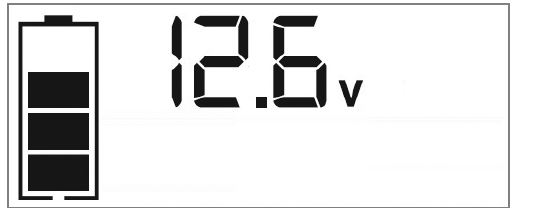
- If the battery charge level is at full capacity, four solid bars will display.
- If the battery is partially charged, two or three solid bars will display.
- If the battery is nearly empty, one solid bar will display. The unit should be charged at this time.
- If the battery is completely empty, four blank bars will display. The unit MUST be charged at this time or the unit’s built-in low-voltage protection will activate. The empty Battery Status Icon will flash for a short period of time before automatically shutdown. The unit will not operate until the battery is recharged.
Note: If no other actions are taken, the unit will automatically power off after 10 seconds.
CHARGING/RECHARGING
- Lead-acid batteries require routine maintenance to ensure a full charge and long battery life. All batteries lose energy from self-discharge over time and more rapidly at higher temperatures. Therefore, batteries need periodic charging to replace the energy lost through self-discharge. When the unit is not in frequent use, the manufacturer recommends the battery should be recharged at least every 30 days and after each use.
Notes: This unit is delivered in a partially charged state – you must fully charge it before using it for the first time. The initial AC charge should be for 40 hours or until the Battery Status Icon shows 4 solid bars.
Recharging the battery after each use will prolong battery life; frequent heavy discharges between recharges and/or overcharging will reduce battery life. The battery can be recharged using the built-in 120 Volt AC Charger.
Make sure all other unit functions are turned off during recharging, as this can slow the recharging process.
CAUTION: RISK OF PROPERTY DAMAGE:
Failure to keep the battery charged will cause permanent damage and result in poor jump-starting performance.
IMPORTANT: If you know the unit is discharged, but the battery icon displays four solid bars as if the unit is fully charged when connected to a charging power source, this may be due to the internal battery having a high impedance. The manufacturer suggests leaving the unit charging for a period of 40 hours using the built-in AC charger before use.
Charging/Recharging Using the Built-In 120 Volt AC Charger and AC Extension Cord
- Lift the protective cover of the built-in 120-volt AC charger located on the lower left front of the unit (refer to the “Features” section to locate). Connect an extension cord to the unit. Plug the other end of the cord into a standard 120‑volt AC wall outlet. When the unit is properly connected to an AC power source, the LCD screen will display the following
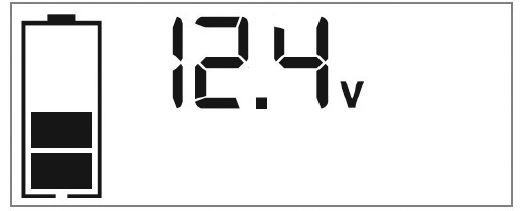
The bars on the Battery Status Icon represent the charge level of the unit’s internal battery. The bars on the Battery Status Icon will change from empty to solid (bottom to top) repeatedly to indicate the unit is charging. The backlight will turn on for 10 seconds (only). - The charge for approximately 40 hours or until the Battery Status Icon shows 4 solid bars.
- When charging is complete, unplug the AC extension cord from the AC outlet and then disconnect it from the unit.
JUMP-STARTER
This unit is equipped with a jump starter power switch that allows energy to flow only when proper connections are made battery and frame.
- For negative-grounded systems, connect the positive (red) clamp to the positive ungrounded battery post and the negative (black) clamp to the vehicle chassis or engine block away from the battery. Do not connect the clamp to the carburetor, fuel lines or sheet-metal body parts. Connect to a heavy gauge metal part of the frame or engine block.
- For positive-grounded systems, connect the negative (black) clamp to the negative ungrounded battery post and the positive (red) clamp to the vehicle chassis or engine block away from the battery. Do not connect the clamp to the carburetor, fuel lines or sheet-metal body parts. Connect to a heavy gauge metal part of the frame or engine block.
IMPORTANT: Make sure the Compressor Power Button has been turned off before attempting to use the unit as a Jump Sta
WARNING: TO REDUCE THE RISK OF INJURY OR PROPERTY DAMAGE:
- FOLLOW ALL SAFETY INSTRUCTIONS FOUND IN THE “Specific safety instructions for jump starters” section of this instruction manual.
- Never touch red and black clamps together — this can cause dangerous sparks, power arcing, and/or explosion.
- If the clamps are connected incorrectly with regard to polarity, the unit will sound a continuous alarm until the clamps are disconnected. The backlit LCD Screen will display the Battery Status Icon, the Battery Voltage Icon and the Clamp Icons. The “+” and”–” signs above the Clamp Icons, the Arrow Icons and the Alarm Icon will flash. The backlit LCD screen will display the following:

CAUTION: The unit will suffer permanent damage if the Jump Starter Power Switch is turned on while the clamps are connected with reverse polarity. Disconnect the clamps and reconnect to the battery with the correct polarity.
- If the Jump Starter Power Switch is turned on and the unit detects that the clamps are not connected to a battery, a two-second warning will sound every 10 seconds. The LCD screen will display the Battery Status Icon, the Battery Voltage Indicator, and the Clamp Icons with the “+” and”–” signs. The Alarm Icon and the Jump Starter Icon will flash. The backlit LCD screen will display the following:

Turn off the Jump Starter Power Switch; connect the clamps to the battery, making sure the clamps are connected with correct polarity; then turn the Jump Starter Power Switch back on. - Always disconnect the negative (black) jumper cable first, followed by the positive (red) jumper cable, except for positive grounded systems.
Procedure
Take the following steps, observing all cautions and warnings in the “Important Safety Instructions” section at the front of this manual.
- Turn off vehicle ignition and all accessories (radio, A/C, lights, connected cell phone chargers, etc.). Place vehicle in “park” and set the emergency brake.
- Make sure the jump-starter power switch is in the off position.
- Remove jumper clamps from clamp tabs. Connect the red clamp first, then the black clamp.
- Procedure for jump-starting a NEGATIVE GROUNDED SYSTEM (negative battery terminal is connected to chassis)
(MOST COMMON)- Connect the positive (+) red clamp to the vehicle battery’s positive terminal.
- Connect negative (–) black clamp to the chassis or a solid, non-moving, metal vehicle component or body part. Never clamp directly to the negative battery terminal or moving part. Refer to the automobile owner’s manual.
- Procedure for jump-starting POSITIVE GROUND SYSTEMS
Note: In the rare event that the vehicle is to be started as a Positive Grounded System (positive battery terminal is connected to chassis), replace steps 4a and 4b above with steps 5a and 5b, then proceed to step 6.- Connect the negative (–) black clamp to the vehicle battery’s negative terminal.
- Connect positive (+) red clamp to the vehicle chassis or a solid, non-moving, metal vehicle component or body part. Never clamp directly to the positive battery terminal or moving part. Refer to the automobile owner’s manual.
- When the clamps are connected properly, the unit will automatically turn on in jump-starter mode. The backlit LCD screen will display the following to indicate the unit is ready to jump-start:

- The Battery Status icon, Battery Voltage Indicator, Clamp Icons and the “+” and”–” signs light solid. The jump starter icon will flash to indicate the clamps are properly connected.
- Turn the Jump-Starter Power Switch on. Turn on the ignition and crank the engine in 5-6 second bursts until engine starts.
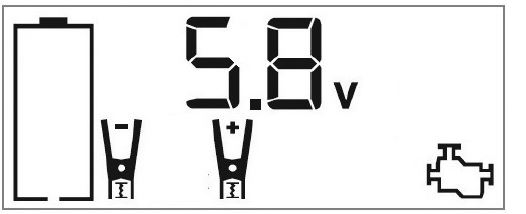
- The backlit LCD screen will display the following:
- The Battery Status Icon, the Battery Voltage Indicator, Jump Starter Icon, Clamp Icons, and the “+” and”–” signs light solid to indicate the unit is jump-starting.
- Turn the Jump-Starter Power Switch off.
- Disconnect the negative (–) engine or chassis clamp first, then disconnect the positive (+) battery clamp.
IMPORTANT: Always turn the unit off when not in use. Recharge this unit fully after each use
CAUTION: TO REDUCE THE RISK OF PROPERTY DAMAGE:
- Vehicles that have onboard computerized systems may be damaged if the vehicle battery is jump-started. Before jump-starting this type of vehicle, read the vehicle manual to confirm that external-starting assistance is advised.
- Excessive engine cranking can damage the vehicle‘s starter motor. If the engine fails to start after the recommended number of attempts, discontinue the jump-start procedure and look for other problems that need to be corrected.
- If the vehicle fails to start, turn off the ignition, turn off the Jump-Starter Power Switch, disconnect the jump-start system’s leads and contact a qualified technician to investigate why the engine did not start.
ALTERNATOR CHECK
Set up the unit and connect to the battery following steps 1 through 5 in the “Jump-Starter” section.
No Load (turn OFF all vehicle’s accessories): The vehicle battery must be fully charged before testing the alternator. Run the engine long enough to achieve normal idle speed and verify there is a no-load voltage.
- Press the Alternator Check Button to start the check. The backlit LCD screen will display the following to indicate the unit is analyzing the alternator:

The Battery Status Icon will light solid and the Alternator Icon will flash. - If the unit detects that the alternator is good, the backlit LCD screen will display the following
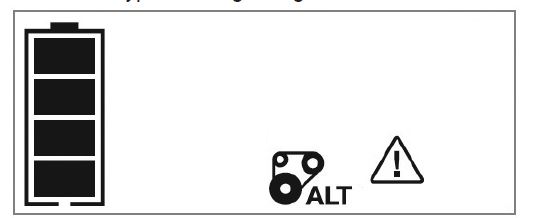
The Battery Status Icon, Alternator Icon, and “ALT GOOD” will light solid. - If the unit detects that the alternator is out of typical voltage range, the backlit LCD screen will display the following

- The Battery Status Icon, Alternator Icon, and “ALT” will light solid. The Fault Icon will flash.
- Press the Alternator Check Button again to stop the test and turn off the unit
ONE-YEAR LIMITED WARRANTY
The manufacturer warrants this product against defects in materials and workmanship for a period of ONE (1) YEAR from the date of retail purchase by the original end-user purchaser (“Warranty Period”).
If there is a defect and a valid claim is received within the Warranty Period, the defective product can be replaced or repaired in the following ways: (1) Return the product to the manufacturer for repair or replacement at the manufacturer’s option. Proof of purchase may be required by the manufacturer. (2) Return the product to the retailer where the product was purchased for an exchange (provided that the store is a participating retailer). Returns to the retailer should be made within the time period of the retailer’s return policy for exchanges only (usually 30 to 90 days after the sale). Proof of purchase may be required. Please check with the retailer for their specific return policy regarding returns that are beyond the time set for exchanges.
This warranty does not apply to accessories, bulbs, fuses, and batteries; defects resulting from normal wear and tear, accidents; damages sustained during shipping; alterations; unauthorized use or repair; neglect, misuse, abuse; and failure to follow instructions for care and maintenance for the product.
This warranty gives you, the original retail purchaser, specific legal rights and you may have other rights which vary from state to state or province to province. This product is not intended for commercial use.
Please complete the Product Registration Card and return it within 30 days from the purchase of the product to: Baccus Global LLC, One City Centre, 1 North Federal Highway, Suite 200, Boca Raton, FL 33432. Baccus Global LLC, toll-free number: (877) 571-2391.
SPECIFICATIONS
- Boost Ampere: 12V DC, 1,000A peak battery, 500A instant
- Battery type: Maintenance-free, sealed lead acid, 12Vdc, 17Ah
- AC input: 120V AC, 60Hz, 13W
- Area light: 3 white LEDs
- USB ports: 5V DC each, 6.2A total (3.1A total in the top two USB Ports; 3.1A total in the bottom two USB Ports)
- Compressor maximum pressure: 120 PSI
Imported by Baccus Global LLC, One City Centre, 1 North Federal Highway, Suite 200, Boca Raton, FL 33432
www.Baccusglobal.com 1-877-571-2391
RD072116
FAQs Stanley FatMax PP1DCS
Why is my Stanley Fatmax beeping so loudly?
The low battery indicator is displayed here. During a power outage, our fatmax kept beeping as it charged a cell phone.
On a Stanley Fatmax, what kind of battery is used?
Replacement Batteries for Stanley Fatmax 700 with Compressor, SPS Brand, 12V 9Ah (Pack 5)
Can you charge a battery using a Stanley FatMax?
I’ve used Fatmax multiple times, and each time it charged my vehicle, lawnmower, boat, electric winch, and gel motorbike batteries flawlessly. This item triumphs over the Battery Untender, which costs three times as much.
How is a Stanley FatMax recharged?How is a Stanley FatMax recharged?
Connect an extension cord to the built-in AC adapter by lifting the AC cover on the front of the device near the handle. 2. Insert the extension cord’s other end into a wall outlet that is powered by 120V AC.
Stanley Fatmax: What is it?
The professional tradesperson and serious home improvement enthusiast should use Stanley Fatmax tools. Thanks to their cutting-edge design, FatMax products are intended to assist you in working more efficiently and quickly. Whether working on-site or at home, the Stanley fat max range has everything you need to get the job done.
What is Stanley Fatmax’s lumen output?
2080 Lumens The 10-watt LED light that powers the Stanley Fatmax 2200 Lumens handheld spotlight is powered by a rechargeable Lithium-Ion battery.
Stanley Fatmax tools are brushless, right?
Increase your output by using the new brushless range. With the same battery pack, the new STANLEY® FATMAX Brushless power tool line offers improved performance.
What is the lifespan of a Stanley jump starter?
Jump starters need to be recharged and are short-lived. Even with proper maintenance, a jump starter will probably only last three to four years. Quality jumper cables, on the other hand, can last a lifetime and will undoubtedly outlive your car.
For more manuals by Stanley Tools, visit ManualsDock [embeddoc url=”https://manualsdock.com/wp-content/uploads/2023/02/Stanley-FatMax-PP1DCS.pdf” download=”all”]


